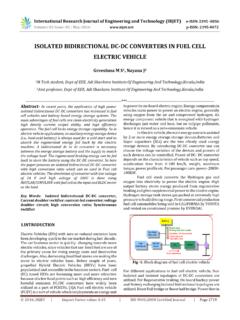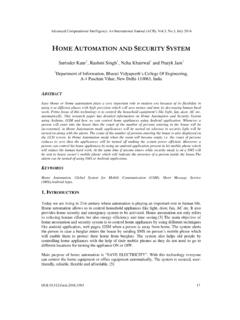Transcription of Home Automation Using Internet of Things
1 2015, All Rights Reserved Page 1965 home Automation Using Internet of Things Vinay sagar K N1, Kusuma S M2 1 Student IV SEM, , Digital Communication. Engg, MSRIT, Bangalore, India 2 Assistant Professor, Department of Telecommunication, MSRIT, Bangalore, India ---------------------------------------- --------------------------------**------ ---------------------------------------- -------------------------Abstract- With advancement of Automation technology, life is getting simpler and easier in all aspects. In today s world Automatic systems are being preferred over manual system. With the rapid increase in the number of users of Internet over the past decade has made Internet a part and parcel of life, and IoT is the latest and emerging Internet technology. Internet of Things is a growing network of everyday object-from industrial machine to consumer goods that can share information and complete tasks while you are busy with other activities.
2 Wireless home Automation system(WHAS) Using IoT is a system that uses computers or mobile devices to control basic home functions and features automatically through Internet from anywhere around the world, an automated home is sometimes called a smart home . It is meant to save the electric power and human energy. The home Automation system differs from other system by allowing the user to operate the system from anywhere around the world through Internet connection. In this paper we present a home Automation system(HAS) Using Intel Galileo that employs the integration of cloud networking, wireless communication, to provide the user with remote control of various lights, fans, and appliances within their home and storing the data in the cloud. The system will automatically change on the basis of sensors data. This system is designed to be low cost and expandable allowing a variety of devices to be controlled. Key Words: home Automation System (HAS), Internet of Things (IoT), Cloud networking, Wi-Fi network, Intel Galileo Microcontroller.
3 In contrast, Wireless systems can be of great help for Automation systems. With the advancement of wireless technologies such as Wi-Fi, cloud networks in the recent past, wireless systems are used every day and everywhere. B. Advantages of home Automation systems: In recent years, wireless systems like Wi-Fi have become more and more common in home networking. Also in home and building Automation systems, the use of wireless technologies gives several advantages that could not be achieved Using a wired network only. 1) Reduced installation costs: First and foremost, installation costs are significantly reduced since no cabling is necessary. Wired solutions require cabling, where material as well as the professional laying of cables ( into walls) is expensive. 2) System scalability and easy extension: Deploying a wireless network is especially advantageous when, due to new or changed requirements, extension of the network is necessary. In contrast to wired installations, in which cabling extension is tedious.
4 This makes wireless installations a seminal investment. 3) Aesthetical benefits: Apart from covering a larger area, this attribute helps to full aesthetical requirements as well. Examples include representative buildings with all-glass architecture and historical buildings where design or conservatory reasons do not allow laying of cables. 4) Integration of mobile devices: With wireless networks, associating mobile devices such as PDAs and Smartphones with the Automation system becomes possible everywhere and at any time, as a device's exact physical location is no longer crucial for a connection (as long as the device is in reach of the network). For all these reasons, wireless technology is not only an attractive choice in renovation and refurbishment, but also for new installations. [1] Sirsath N. S, Dhole P. S, Mohire N. P, Naik S. C & Ratnaparkhi This paper proposes a home Automation system that employs the integration of multi-touch mobile devices, cloud International Research Journal of Engineering and Technology (IRJET) e-ISSN: 2395-0056 Volume: 02 Issue: 03 | Jan-2015 p-ISSN: 2395-0072 I.
5 INTRODUCTION: A. Overview: Homes of the 21st century will become more and more self- controlled and automated due to the comfort it provides, especially when employed in a privat e home . A home Automation system is a means that allow users to control electric appliances of varying kind. Many existing, well-established home Automation systems are based on wired communication. This does not pose a problem until the system is planned well in a dvance and installed during the physical construction of the building. But for already existing buildings the implementation cost goes very high. II. RELATED WORK 2015, All Rights Reserved Page 1966 networking, wireless communication, and power-line communication to provide the user with remote control of various lights and appliances within their home . This system uses a consolidation of a mobile phone application, handheld wireless remote, and PC based program to provide a means of user interface to the consumer.
6 [2] Basil Hamed The main objective of this Paper is to design and implement a control and monitor system for smart house. smart house system consists of many systems that controlled by LabVIEW software as the main controlling system in this paper. Also, the smart house system was supported by remote control system as a sub controlling system. The system also is connected to the Internet to monitor and control the house equipment s from anywhere in the world Using LabVIEW. [3] Deepali Javale, Mohd. Mohsin, Shreerang Nandanwar The prime objective of this paper is to assist handicapped/old aged people. It gives basic idea of how to control various home appliances and provide a security Using Android phone/tab. The design consists of Android phone with home Automation application, Arduino Mega ADK. User can interact with the android phone and send control signal to the Arduino ADK which in turn will control other embedded devices/sensors. [4] Basma M.
7 Mohammad El-Basioni, Sherine M. Abd El- kader and Mahmoud Abdelmonim Fakhreldin This paper proposes a new design for the smart home Using the wireless sensor network and the biometric technologies. The proposed system employs the biometric in the authentication for home entrance which enhances home security as well as easiness of home entering process. The structure of the system is described and the incorporated communications are analyzed, also an estimation for the whole system cost is given which is something lacking in a lot of other smart home designs offers. WB-SH is designed to be capable of incorporating in a building Automation system and it can be applied to offices, clinics, and other places. The paper ends with an imagination for the future of the smart home when employs the biometric technology in a larger and more comprehensive form. The paper ends with an imagination for the future of the smart home when employs the biometric technology in a larger and more comprehensive form.
8 III. SYSTEM ANALYSIS A. Problem Definition home Automation systems face four main challenges, these are high cost of ownership, inflexibility, poor manageability, and difficulty in achieving security. The main objectives of this research is to design and implement a home Automation system Using IoT that is capable of controlling and automating most of the house appliances through an easy manageable web interface. The proposed system has a great flexibility by Using Wi-Fi technology to interconnect its distributed sensors to home Automation server. This will decrease the deployment cost and will increase the ability of upgrading, and system reconfiguration. B. Proposed System Feature The proposed system is a distributed home Automation system, consists of server, sensors. Server controls and monitors the various sensors, and can be easily configured to handle more hardware interface module (sensors). The Intel Galileo development board, with built in WiFi card port to which the card is inserted, acts as web server.
9 Automation System can be accessed from the web browser of any local PC in the same LAN Using server IP, or remotely from any PC or mobile handheld device connected to the Internet with appropriate web browser through server real IP ( Internet IP). WiFi technology is selected to be the network infrastructure that connects server and the sensors. WiFi is chosen to improve system security (by Using secure WiFi connection), and to increase system mobility and scalability. IV. SYSTEM DESIGN AND IMPLEMENTATION A. Proposed home Automation System: Figure 1: Proposed model of home Automation system International Research Journal of Engineering and Technology (IRJET) e-ISSN: 2395-0056 Volume: 02 Issue: 03 | Jan-2015 p-ISSN: 2395-0072 2015, All Rights Reserved Page 1967 The proposed model of the home Automation system is as shown in the figure1.
10 The model consist of different sensors like temperature, gas, motion and LDR. Initially the Intel Galileo connects to the Internet through WiFi. When the connection is established it will start reading the parameters of sensors like p1, p2, p3 etc. The threshold levels for the required sensors are set as t1, t2, t3 etc. The sensor data are sent to the web server and stored in the cloud. The data can be analyzed anywhere any time. If the sensor parameters are greater than the threshold level then the respective alarm a1, a2, a3 etc. will be raised and the required actuation is done for the controlling of the parameters. In the proposed model the temperature, gas leakage, motion in the house is monitored. The temperature and the motion detection is stored in cloud for analysis. If the temperature exceeds the threshold level then the cooler will turn on automatically and it will off when the temperature comes to control. Similarly when there is a leakage of gas in the house alarm is raised giving the alert sound.














